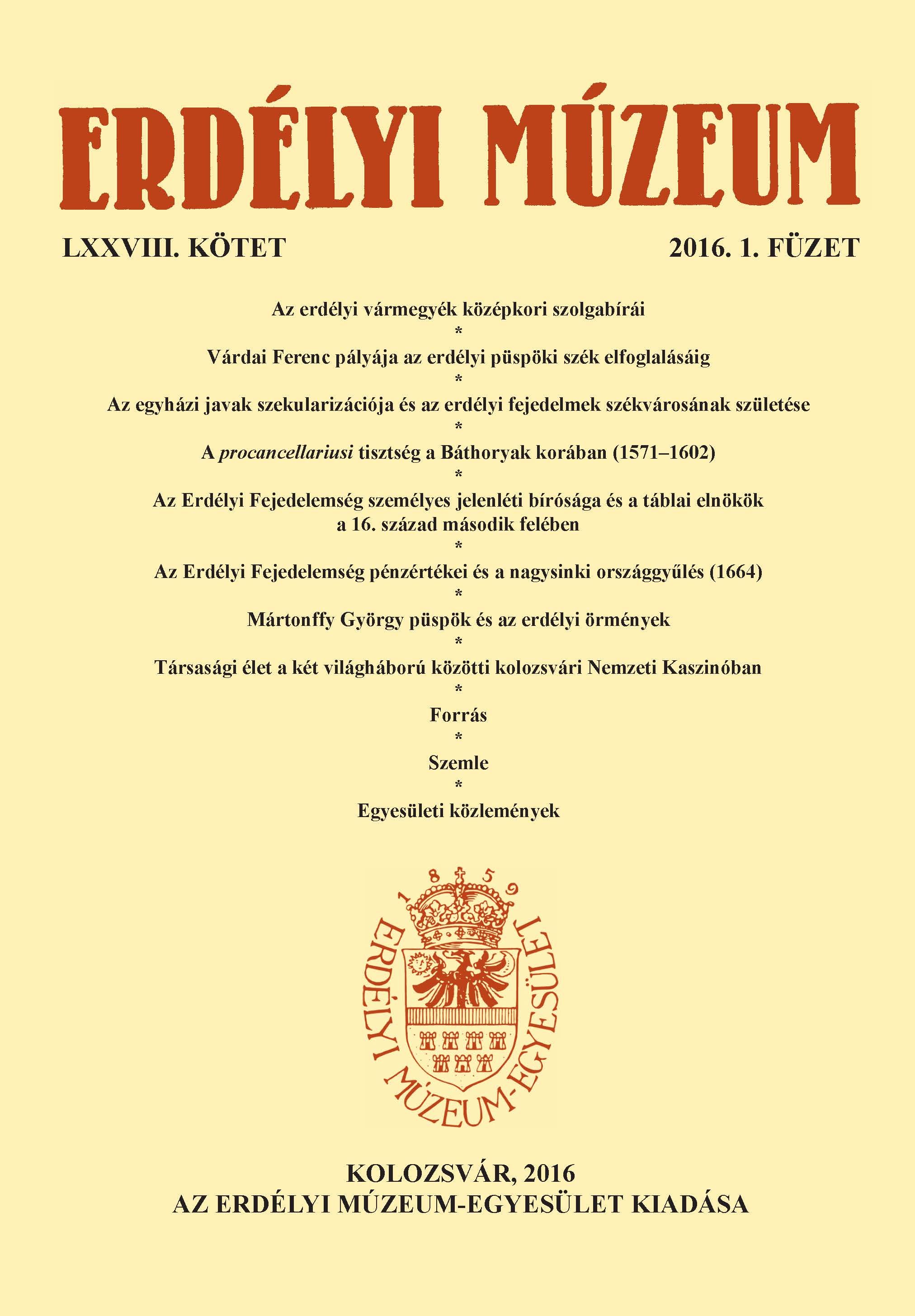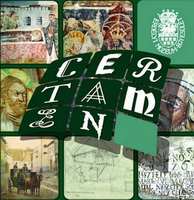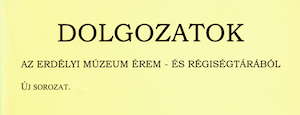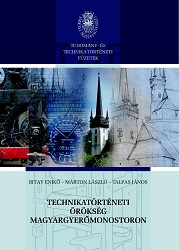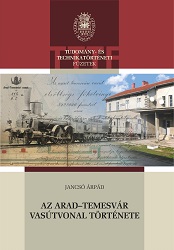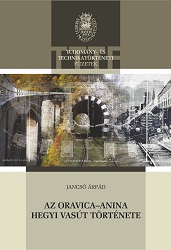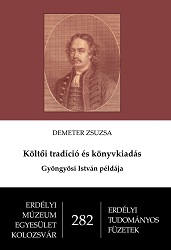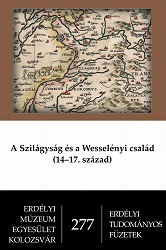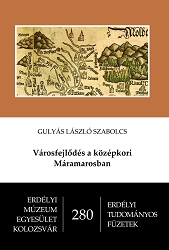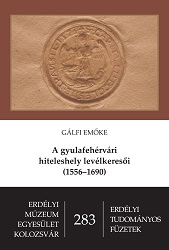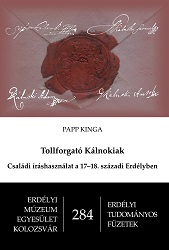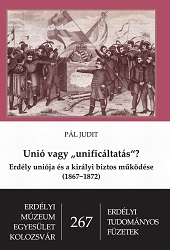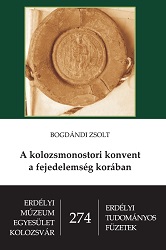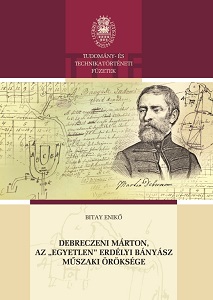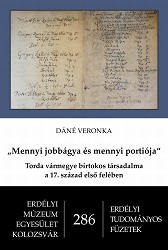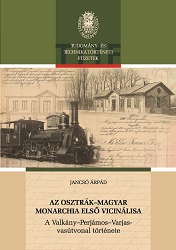„Mennyi jobbágya és mennyi portiója”. Torda vármegye birtokos társadalma a 17. század első felében
Author(s): Dáné Veronka / Language(s): Hungarian
Keywords: Transylvanian noble land distribution;16th century;
“The question of the distribution of estates in 16th-17th Transylvania (the fundamental question of the estate system in the era of the Principality) is still waiting for an answer,” as the most accomplished expert of the history of the Transylvanian Principality, Zsolt Trócsány claimed in 1976.The importance of the subject is indicated by a later reference, when in 1980, in connection with the origins of the office-holders of the central administration, he returns to the question: “One may ask, to what extent could a complete exploration of the distribution of estates among members of 16th-17th century Transylvanian nobility assist us in this question? In light of the available sources, such an exploration could certainly not grasp the strata of minor noblemen with only a few plots, those inherently born into the strata of intellectuals, or burghers either. However, it would probably reveal an order in connection with the aristocracy and the county nobility. How much financial power do Transylvanian peers possess, how does the financial potency of individual families grow or diminish – there is probably a more certain answer to this question, even if it requires a significant amount of research.” Almost four decades later, it is not simply the expected answer that is still absent, but even the recommended research has not started until the turn of the 20th-21st century. This is, of course, in part due to the conditions of research hindered by the Communist dictatorship in particular for Hungarian researchers. It is also true that because of the range of available sources, a complete mapping of the society of Transylvanian peers, and the distribution of estates requires much more eff ort than in the case of the Kingdom of Hungary. For, in the case of the Principality, there are no more or less continuous series of ‘conscriptios’ like those preserved in the Archive of the Hungarian Chamber. From the 150 years of the autonomous Transylvanian state, in a hugely unequal distribution, we have a maximum of 12 such ‘conscriptios’ available for any county, that is, specific information is only available from 12 years. Apart from fiscalis estates, up to the mid- or late 17th century, land terriers (urbarium), or ‘conscriptios’ related to serfs, and other estaterelated materials are only occasionally preserved in the archives of Transylvanian families. Even after this period, we are not abounding with sources. This is partly due to the fact that such outdated fiscal documents have already been “scrapped” by their respective owners, and the constant destruction and scattering of Transylvanian archival material over the course of time did not help either. Therefore, in order to make up for these losses at least to a certain degree, researchers must first of all recover every related archival source to the greatest extent possible, which means that any such undertaking demands at least a decade of work.The volume – relying on the research launched in the late 1990s covering the history of noble counties – makes the first step towards an exploration of the distribution of estates among members of the mobility in the era of the Principality by presenting the community of estates in Torda county in the beginning of the 17th century (from 1603 to 1658) based on the only 17th century record available for the county, the portalis conscriptio from 1616. The snapshot is expanded by the author with information from county protocols, family archives etc., in order to get a more complete picture, and she follows the micro-historical method employed by Zsigmond Jakó, that is, wherever possible, she tries to cover the history of all the members (or those members who can be considered typical) within each category of estate owners, together with the history of the respective pieces of estates. The starting year, 1603 is the year of the Battle of Brassó (Braşov), which – because of a large-scale extermination of noble families, and the subsequent exchange of estate owners – is a watershed event not only according to the historiographer Szamosközy, but according to the sources, too, and similar changes took place in 1658, at the beginning of the second rulership crisis. At the same time, the ‘conscriptios’ from 1573 and 1575 discovered during the course of research provided an opportunity to outline the estate society of the county in the mid-/late-16th century, too, therefore the processes can be traced over an 80-year-long time span. The sources from the two centuries highlighted the degree of uncertainty and the resulting misunderstandings concerning the use of the term ‘porta’ which served as the basis for taxation. Namely, critical literature used a unified key of 1 plot = 10 serfs introduced in 1608 for the whole period of the Principality, but this is wrong. In the period preceding 1608, the autonomous Transylvanian state almost certainly carried on with the tradition inherited from the Kingdom of Hungary, and thus, in the 16th century, plot probably meant serf farms with a wealth of three, six, then twelve forints. The destruction caused by the Fifteen Years War forced the administration to eliminate the minimum wealth. (The Kingdom of Hungary introduced similar measures for the same reasons: from 1608, four serfs or 12 inquilini [inquilinus / ‘zsellér’] constituted one ‘porta’.) Therefore, since the content of ‘porta’ is diff erent, the number of ‘portas’ before and after 1608 cannot be compared. Another problem is the definition of the different categories (large, medium and small estate owners), and the classification of the possessors within these categories, since the image is subject to change until the full exploration of the distribution of estates in Transylvania. Therefore, the author stuck to the terms large, medium and small estate owners, but regards them as valid exclusively with reference to the investigated county.Within the present framework, the changes in the estate owner society of the county could only be illustrated with the numerical data of the investigation. In the 1570s, the biggest estate owner of the county was the Treasury/the Prince, with the three bordering castle estates (Görgény [Gurghiu], Léta [Liteni], Vécs [Brâncovenești]), it controlled more than 44% of the ‘portas’. As for private estates, in terms of estate size, 77% of the total possessors in the county were small estates, owning a mere 1-10 ‘portas’ (and a quarter of this category only owned one ‘porta’). As for the ancestry of the county, it seems that the majority (77%) of the families who owned estates here before Mohács managed to preserve their possessions until this period in a more or less intact state. In Torda county, settlement from other parts of the Kingdom of Hungary, which was, according to Zsigmond Jakó, quite significant in Doboka county, was less characteristic. Only a quarter of the estate owners have turned up simultaneously with the Transylvanian state, or later. It cannot be denied, however, that the fragmentation of estates, and the loss of estates on the distaff side increased by the 1570s, 1580s. During the first half of the 17th century, significant changes happened. Above all, until the rule of the Rákóczis, the fiscus/treasury had become virtually invisible (whereas, for example in Inner-Szolnok it had become predominant). The Léta estate was completely parcelled out, whereas the Görgény and Vécs estates migrated to private estate owners as ‘inscriptio’. Like in the previous period, the proportion of small estate owners remained relatively high, almost half of the possessors owned half a ‘porta’, or less than five serf families/farms or less. As for ancestry, the number of estate owners who had been here before Mohács or in the first half of the 16th century fell below 40% percent in all the three categories, which indicates the destruction caused by the Fifteen Years War. Holding of county offices was characteristic of middle (2-9 ‘portas’) and small (0.5-2 ‘portas’) estate owners, in the case of the latter, obviously for the sake of financial gain. Zsigmond Jakó, in his broad comparison of the two counties, arrived at the following conclusion: “Doboka is characterised by good medium estates and constancy, Belső-Szolnok (Szolnok Interior) by large estates and vivacity.” Torda was somewhere between these two: it preserved way more of its ancient families than Inner-Szolnok, but the proportion and the weight of medium estates was smaller than in Doboka, and there was a certain amount of vivacity in the estate relations of the county. Already the examination of these three counties shows that there is no place for generalisations here. The seven Transylvanian noble counties can be regarded as “septuplets”, but their respective “personalities” are different. And this, in our opinion, is to a signifi cant extent a result of nothing else, but the composition, proportions and unique characteristics of their estate societies, which profoundly determines how a given county’s noble universitas behaves as a community.The results of the research are probably not as fruitful in the case of large estate owners influential in the political course and administration of the country as in the case of the lower strata. However, to a certain number of questions listed by Trócsányi (like the commencement of the officeholder commoner and small estate owners, the administrative intellectuals, the government administrators, and the history of intellectual dynasties) it yielded basic information, and also the clouds shadowing the distribution of estates, which is thought to be the fundamental question of the estate system, are starting to dissipate at least in connection with one county.
More...
